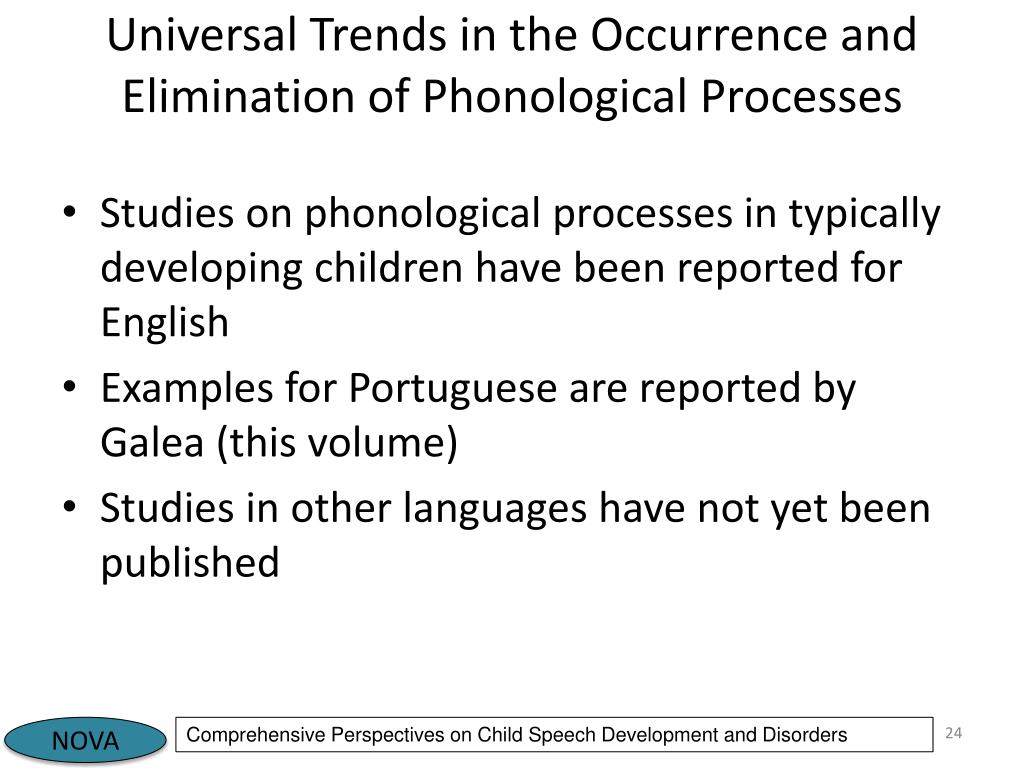
The replacement of one class of sounds, with another class of sounds (e.g., “Get” → “Det”) Table 1 provides a description of these three different types: Phonological processes have been classified into three different types of categories: substitution processes, syllable structure processes, and assimilation processes. In fact, it is arguably more surprising to see a 2-year old with “perfect” adult speech, than it would be a 2-year old with sound errors. These patterns are completely natural and expected. Childrens’ brains learn these patterns of speech sound errors, which are called phonological processes. As children develop speech-language skills, they simplify words until they have learned to articulate all sounds in words appropriately. Why does this happen? While learning to coordinate the tongue, lips, jaw, teeth, and palate to make speech sounds, all children will display speech sound errors. §Typically eliminated by 2.Do you ask, what is are phonological processes? Have you ever heard your child say words like “wain” for “rain”, or “pane” for “plane”? For some, it can be extremely cute to hear a child speak in this manner, and while it’s a natural characteristic of speech development, it’s definitely something worth learning more about. I.“nose†may be pronounced “dozeâ€

Denasalization – the substitution of a nasal consonant (“n†or “mâ€) with a non-nasal consonant (“b†or “dâ€) Ii.“daddy†may be pronounced “dada†I.“bottle†may be pronounced “baba†§Typically outgrown by age three but can linger until age nine in more severe cases of phonological delayĢ.Reduplication – the repetition of a complete or incomplete syllable in substation for a word. Ii.“name†may be pronounced “mame†§The unstressed syllable is usually the one children eliminateĪssimilation processes: when sounds/syllables start to sound like surrounding soundsġ.Assimilation – when a consonant sound in a word starts to sound the same as another consonant in the word Iii.“remote†may be pronounced “mote†Ii.“Vanilla†may be pronounced “nilla†I.“Computer†may be pronounced “puter†§Typically experienced by children with more sever phonological delaysĤ.Syllable reduction – the elimination of a syllable from a word that contains two or more syllables Ii.“cape†may be pronounced “ape†I.“belly†may be pronounced “elly†§Usually outgrown by 4 years old except for words starting with “sâ€Ģ.Final Consonant Deletion – the elimination of the final consonant in a word.ģ.Initial consonant deletion – the elimination of the beginning consonant of a word. Iii.“Free†may be pronounced “fee†Ii.“Stay†may be pronounced “say†Syllable Structure Processes: syllables are reduced, omitted or repeatedġ.Cluster reduction – the reduction of a consonant cluster (two consonants next to one another) to one consonant. Iii.“gate†may be pronounced “date†I.“cookie†may be pronounced “tootie†§Depending on the fricative sound this process is eliminated between the ages of three and sixĥ.Fronting – the term used when sounds that should be made in the back of the mouth (velar) are replaced with a sound made in the front of the mouth (alveolar). Iii.“dress†may be pronounced “dretâ€

Ii.“puzzle†may be pronounced “puddle†Iii.“care†may be pronounced “cayuh†Ii.“river†may be pronounced “rivuh†I.“apple†may be pronounced “appoh†§Typically only occurs in children with more sever phonological delaysģ.Vowelization – the substitution of a vowel sound for “l†or “er†sounds.

Iii.“cat†may be pronounced “cak†I.“duck†may be pronounced “kuck†Iii.“yellow†may be pronounced “yeyyoâ€Ģ.Backing – the substitution of a sound produced in the front of the mouth (like “t†or “nâ€) with a sound produced in the back of the mouth (like “k†or “gâ€). Ii.“play†may be pronounced “pway†I.“rail†may be pronounced “wail†Substitution Processes: replacing one class of sounds for another class of soundsġ.Gliding – the substitution of a liquid sound (typically letter “l†or “râ€) with a glide sound (letters “wâ€, “y†or “jâ€). By age five most children naturally outgrow their use of phonological error patterns. They do this because they lack the ability to appropriately coordinate their lips, tongue, teeth, palate and jaw for clear speech. Phonological processes: patterns of sound errors that typically developing children use to simplify speech as they are learning to talk.


 0 kommentar(er)
0 kommentar(er)
